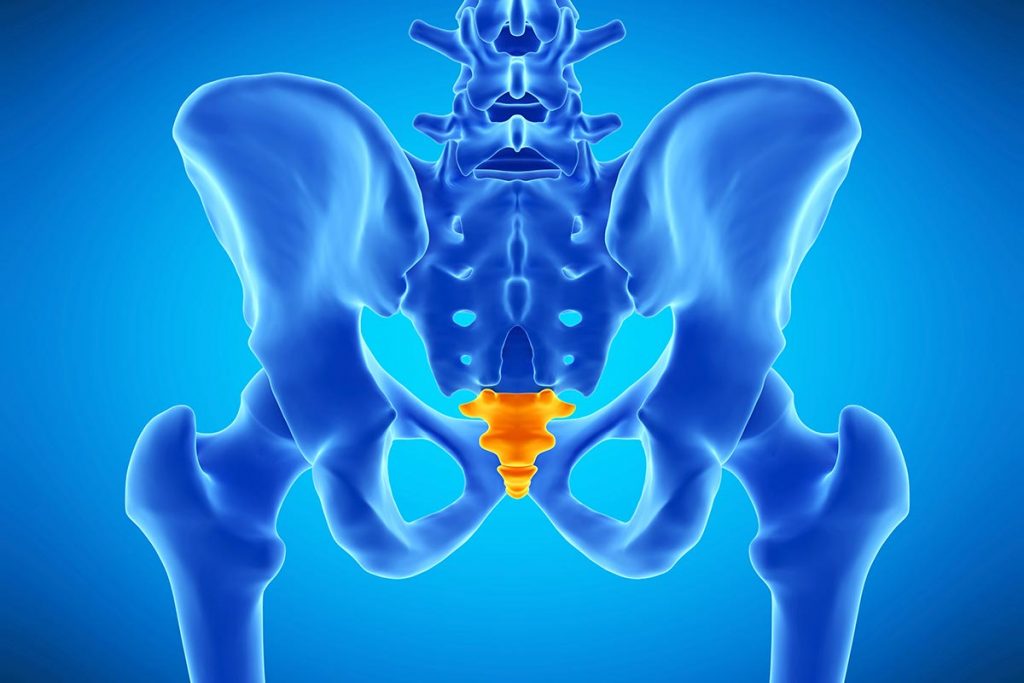The Coccyx is the bone at the very base of the spine and is commonly called the tailbone. The part of the spine just above the tailbone is called the “sacrum”. There is a joint between the sacrum and coccyx called the “sacro-coccygeal” joint.
The coccyx is actually the remnant of a tail but over thousands of years we have evolved and no longer need a tail. We just have a coccyx.
The coccyx provides an anchor point for the pelvic floor muscles. The pelvic floor muscles attach at the front of your pelvis to your pubic bone, and pass to the left and right just inside the sit bones, then back to the coccyx. When you tighten your pelvic floor, the coccyx is drawn gently forward.
When you sit down the coccyx is cushioned by your glute muscles and there is gentle movement at the sacro-coccygeal joint so that so that you don’t feel uncomfortable in the coccyx.

So how and why does the coccyx become painful?
The most common cause of coccyx pain is a fall back onto the coccyx. This could be all sorts of injuries where the feet slide out in front you as you thump back down onto your bottom: slipping on a wet floor; slipping down a wet grassy slope; falling down some steps or stairs; falling off a skateboard; falling back during snow sports and so on and so on.
You might have been dumped in the surf: picked up by the waves and dropped back hard onto the ocean floor. The same soft tissue injuries or joint injuries occur.
What have I injured?
When you fall you might cause a jolt to the sacro-coccygeal joint which will become stiff and painful when you sit, and/or you may cause a soft tissue injury to the muscles around the coccyx. These are your pelvic floor muscles and the glute muscles can also be involved. The ligaments all around the sacrum and coccyx can be sprained ie stretched and injured causing pain and stiffness.
In some cases the coccyx is fractured (broken). The pain in this case is most likely to be absolutely excruciating. If you present to your Doctor or to emergency with extremely severe coccyx pain and cannot sit down at all, an x-ray will be taken to check whether there is a fracture.
Childbirth
The coccyx can be injured during childbirth: If you actually look at a life size model of a pelvis, you will see that the distance between the coccyx and the pubic bone at the front is quite small. Luckily the hormones of pregnancy and delivery cause the joints of the pelvis to give and widen so the baby can be delivered safely with no injury to mother or baby. But sometimes, things don’t go completely to plan: the coccyx can be injured during the delivery making it painful to sit. This can be devastating for a new Mum trying to get to grips with feeding and all the physical demands of having a baby, let alone dealing with pain whenever you sit.
What about sitting for too long?
We often meet people who tell us that their pain came on after a period of prolonged sitting. This could be say, a very long car journey, or sitting to study for long periods, or sitting in a different chair or posture longer than usual. In my experience, when you question further, there are signs that the muscles of the pelvic floor were already a little tense or sore and the long sitting was the last straw. I have often met people with this history: there has been a period of long sitting but there have been other little signs of pelvic floor tension: slight discomfort during sexual activity, bowel pain, pain or spasms emptying the bowel for example. Or there has been a history of an injury that didn’t quite fix fully. Then the episode of prolonged sitting is the last straw. The coccyx becomes really painful whenever you sit down.
What does treatment involve?
We will look for any pelvic asymmetry, how your joints are moving. Is there a low back problem, are there any other injuries causing pressure on the coccyx….?
We will feel the pelvic floor from the outside:
with your consent, we will examine the coccyx right to the tip and then feel through the pelvic floor muscles to the left and right. You will know pretty quickly if this is your pain. We will apply manual therapy to muscles.
Perhaps the sacro-coccygeal joint is stiff after an injury. We can restore normal movement with mobilisation to this joint.
If the pelvic floor muscles are tense and tight and painful, we can show you how to relax and release the pelvic floor.
You may have heard that the best treatment for coccyx is from inside. Yes, the coccyx can be treated from the rectum! But please rest assured, this is only ever done when we have exhausted other options and you will have a deep sense that the pain is so deep inside that this is necessary. Sometimes this gives miraculous relief.
If we can’t make distinct changes in a short time, we will refer you on for investigation.
As Pelvic Health Physios, we are well trained to help you with this debilitating problem.


